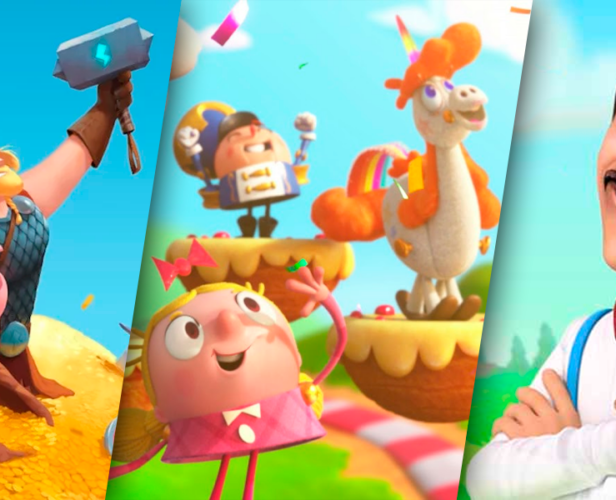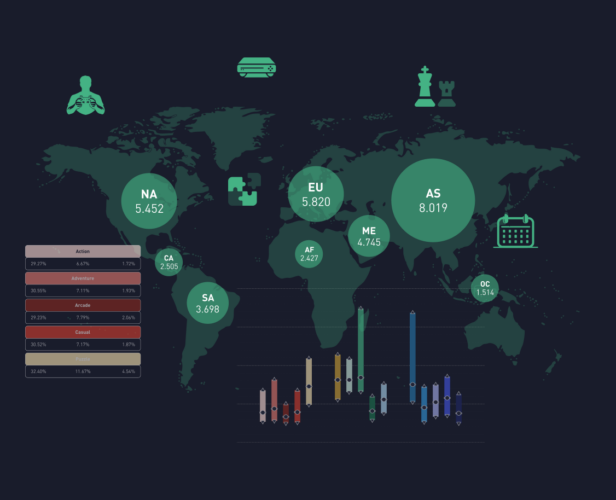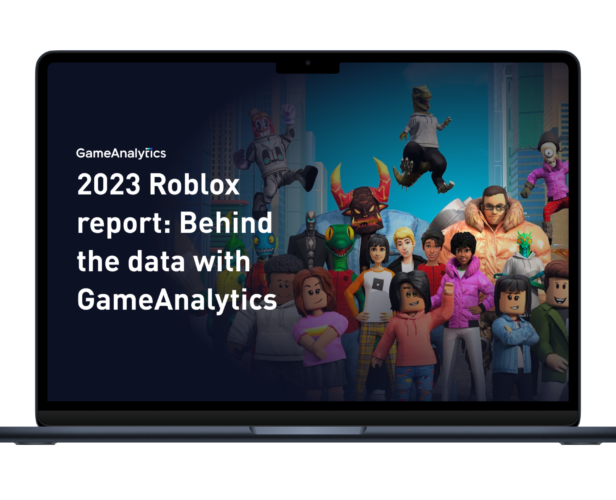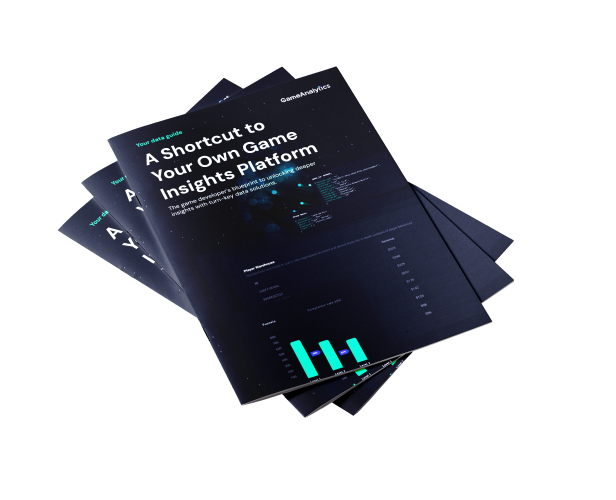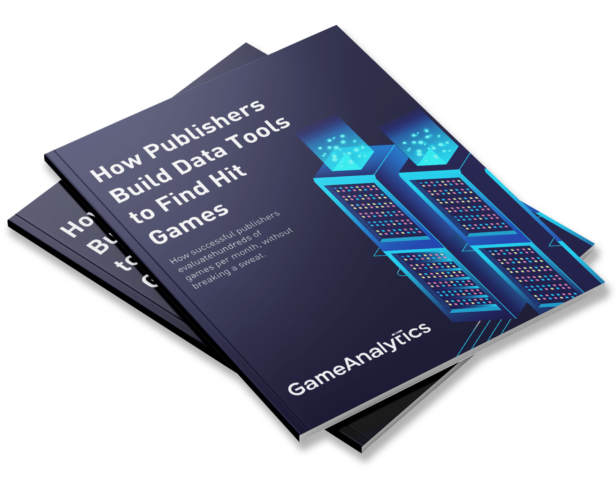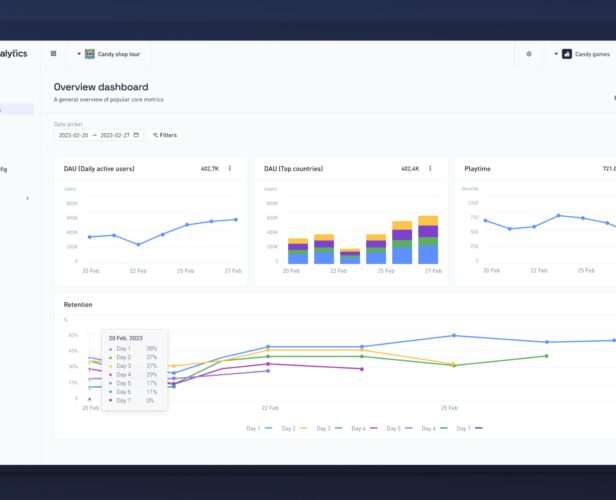Resources > All
Insights and tips about the games industry
Subscribe for gaming insights, industry reports and product updates delivered straight to your inbox.
#Data & Analytics
Genres, Brands and Features: All You Need to Know About the Chinese Mobile Games Market
Editor’s Note: this post was originally published by Kalle Heikkinen, Chief Game Analyst at GameRefinery. With over 400 games analyzed under his belt, Kalle has a solid understanding of what works and what doesn’t in the mobile game market. 800 million mobile internet users, 550 million mobile gamers, 18 billion dollars of annual revenues – the Chinese mobile games market is like no other; attractive and unignorable. The market is a minefield of challenges as well though. From finding the right publishing partner to adjusting to the quirks of the Chinese government (we all remember what happened with approving new game licenses last year). With that said, it is more important than ever to know what the landscape of the world’s biggest mobile games market looks like. In this blog post, our friends at GameRefinery make an attempt to chart it in terms of:...
#AI
How AI Could Change The Way We Build Video And Mobile Games
“I’m sorry Dave. I’m afraid I can’t do that.” If you’re a sci-fi film fan or (ahem) of a certain age, that quote from HAL 9000, the sentient computer and antagonist of ‘2001: A Space Odyssey’, will likely have sent a small shiver down your spine. Artificial intelligence, or AI, has long been a go-to Hollywood villain – think Skynet, Ultron and, arguably the most evil of them all, Proteus IV from ‘Demon Seed’. Luckily, though, science fact hasn’t mirrored fiction (not yet, at least) and “friendly AI” is now in almost all our homes in the form of Siri, Cortana, Alexa and the like. It’s also used in more mundane processes like search engines, email filtering, and chatbots. However, AI in game design needs to catch up. Chances are you’ve heard lots about AI playing games – famous examples...
#Ads & Monetization
Keeping Your Head: A Beginner’s Guide To Header Bidding In Mobile Games
Today we’re exploring the world of header bidding and ad monetization for mobile games. If that just made you say ‘huh?’, then this is the post for you. We’ll go through the basics, the advantages and disadvantages, and demystify the acronyms and jargon that surround it. So the next time someone starts talking about eCPM or RTB, you’ll know what’s fluff and what’s truly significant for your studio. Jargon buster It’s impossible to talk about ad mediation without using jargon and industry terms. So before we get started, take a look at this cheat sheet of words and phrases that you’re going to come across both in this post and elsewhere (it’s in alphabetical order). Ad mediation – the basics Before we get into the ins and outs of header bidding, let’s set the foundation by starting with how ad...
#Data & Analytics
Overview of the Current Mobile Sports & Racing Games Market
A couple of months ago, GameRefinery took a look at the Match3 market and RPG market to see what types of games are driving revenues there. In this blog post, they shift their focus to mobile Sports & Racing games and examine how various games in this category are currently faring on the market. Before we dive further into the data, it’s good to understand how GameRefinery views the mobile games market in terms of genres and game types. In order to classify games in a meaningful way, they take into consideration games’ feature-set, theme and defining mechanics, resulting in a three-layered taxonomy where every game is assigned into a one (and only one) i) Category -> ii) Genre -> iii) Subgenre. For example, Summoners War would go under Midcore -> RPG -> Turn-based RPG. If you’re interested in reading more about...
#Ads & Monetization
15 Ad-Tech Terms Every Mobile Game Developer Should Know
Ad-tech is starting to get all the more significant in the mobile games industry, so it’s important that you’re schooled up. To give you a hand, we’ve put together some of the top key terms you need to be familiar with, in alphabetical order (feel free to bookmark this page, by the way, as we’ll likely keep this updated with new terms we come across). Ad exchange Online marketplaces where publishers, advertisers, agencies, ad networks, DSPs and SSPs can buy and sell ad inventory from each other. Ad fraud Ad fraud is when an advert says it’s been seen, but a human has never actually looked at the ad. And the reason why it’s fraud is because there’s still a cost attached to this impression. Ad inventory The total amount of space a publisher has available on their site or...
#Marketing & Publishing
3 Strategies to Grow Gamers’ Loyalty and Retention Rate
We gamers are a fickle bunch. For a lot of mainstream gamers, “Shiny New Toy” syndrome is all too prevalent. However, some of the older and more dedicated players can easily sit down with the same title they’ve been playing for years and still have a blast. Such is the gaming scene. So amidst this, how do you foster loyalty among your gaming audience? And how can you make sure they keep coming back? There are a few things that you can do, and luckily for you, we’ve listed 3 of them below… 1. Pay Attention to Your Audience As a game developer, one of the worst things you can do is overlook valuable feedback from your players. While playing through your game, your players will push the boundaries of all your design choices, and will almost always find something...
#Ads & Monetization
Casual Game IAP Monetization Trends
Editor’s Note: this post was originally published by Joel Julkunen, Head of Game Analysis at GameRefinery. In his role, he leads GameRefinery’s analytics department and has a major role in developing algorithms and statistical models used in the company. Since the early days of free to play mobile gaming, monetization has been the talk of the town. Resistance, reluctance and rage were common among mobile gamers as designers were trying to figure out this revolutionary business model and its mechanics. Today things have fortunately changed quite a bit, but getting monetization right still isn’t easy – far from it! In this post, GameRefinery takes a look at some of the recent macro trends in casual game IAP monetization. This short read should hopefully give you insights and inspiration to take your monetization to the next level. What Are Casual Games?...
#Case study
How JoyPac uses GameAnalytics to evaluate games for publishing in Asia
Having released 18 successful mobile games in a 7 month period, JoyPac is proving that hyper-casual titles can make it big in Asia. The founding team at JoyPac has decades of experience releasing mobile games across the globe, including throughout Asia. They have first-hand knowledge of the pitfalls that most Western game developers face when trying to break into these markets. That’s why JoyPac was founded on a strong belief of improving transparency, clear communication, and building close partnerships with game developers looking to break into Asia. GameAnalytics helps JoyPac deliver on that promise with uncapped access to global performance data, giving their partners the ability to analyze and optimize their stats – for free. JoyPac’s Western team is based in Copenhagen, which helps them address a lot of the problems that developers often encounter when dealing with publishing partners...
#Data & Analytics
How To Conduct User Research In The Prototype Stage For Your Game
Whether it’s your game concept or your core game features, prototyping and testing ideas at an early stage can you let you know a lot about the health of your game, and more specifically, if people are actually going to enjoy it. Ideally, you’ll want to make sure your title is popular the moment it hits the market. Not only is testing in the early stages of development good for getting your game out there, but it can also help you focus your production process on features that will make the most impact on your intended audience. In this post, you’ll find the steps you need to take when conducting user research during that all-important prototype phase. We’ll include a bunch of different examples of specific test methods (with pros and cons of each) as well as advice for pulling...
#Game Deconstructions
How Coin Master Disrupted Social Casino And Pocketed $100M
Editor’s note: This post was orginally written by Om Tandon (Founder/Games Consultant at UX Reviewer.com) and Abhimanyu Kumar (Mobile Games Consultant) on Deconstructor of Fun. The State of Social Casino When breaking up the mobile gaming market according to Game Refinery’s taxonomy, the “Casino” (aka Social Casino) category is the third largest by revenue – and it has steadily been growing over 2018. Category revenue grew by +24% YoY, and the “Slots” sub-genre contributed to ~70% of this growth. “Slots” generate anything between an average of 70-80% of real world casino revenues, and the same engagement behaviour is mirrored in the Social Casino space. “Slots” are the largest revenue generating sub-genre of the Casino category, occupying a 78% share. Read more about our thoughts around this category and its future in our 2019 Casino category prediction post. * Ad revenues...
#Data & Analytics
Blue-Green Deployments on Terraform (For 850 Million Monthly Active Players)
In this post, you'll get a sneak peak into how we improved our infrastructure deployment practices, all by utilising the “Blue-Green deployment approach”.
#Data & Analytics
Popularity Of Mobile Game Art Styles And Genres – Data Breakdown
Editor’s Note: this post was originally published by Erno Kiiski, Chief Game Analyst at GameRefinery. In his job, he’s played and analyzed hundreds of titles on a feature level, giving him a strong sense of the current mobile game market. This time round, our friends at GameRefinery take a look at the visual elements of top mobile games on the market. They take a deep dive into which game art styles and genres are rocking the US, Chinese and Japanese markets, breaking data down on a game category level to understand their popularity in different game types. Before diving deeper, it’s good to understand how GameRefinery view the mobile game market in terms of genres and game types. In order to classify games in a meaningful way, they take into consideration games’ feature-set, theme and defining mechanics. This creates a three-layered...
#Game Deconstructions
Deconstructing Meta Features In Social Casino Games (With Examples)
Why study social casino games? There’s a huge amount that any developer can learn from social casino games. The casino genre has some of the most avid and engaged types of players, and developers have therefore built many sophisticated meta game features in order to support the success of these types of titles This means you can find a much greater array of unique rewards, challenges or even enhanced purchasing options that provide an important distinction and added value to the players that dedicate a lot of their time to these types of games. People don’t play for real money here, so these features are crucial in order to keep them engaged. So, that’s why we’ve written this post – to showcase some of the most innovative ways to complement your core game and keep your players engaged. We look...
#Editor's pick
Game data pipeline: Building vs buying
As a large number of studios, publishers, and game developers are heavily relying on data to guide their decisions, they need to decide between building or buying. But which one is more efficient? To assist you in understanding the Total Cost of Ownership (TCO), we broke down the following key considerations: Setup requirements Cost calculation Team needs and recruitment
#Editor's pick
Mobile gaming benchmarks for Q1 2024
Uncover the industry’s performance with Q1 2024 benchmarks. Explore key metrics like retention rates and session engagement to benchmark your games against industry standards. What’s inside? Retention benchmarks for casual, classic, and mid-core games Session length benchmarks for games launched in North America, Europe, the Middle East, and Asia Session count benchmarks across 15 game genres
#Editor's pick
Grow your revenue with Xsolla Web Shop for Mobile Games
“Xsolla anticipated this seismic shift earlier this year, when we launched multiple products that are being actively used by some of the world’s largest game companies to increase profit and build closer relationships with their mobile and pc players. We’ve now combined these products and learnings into an elegant new solution called Xsolla Web Shop for Mobile Games,” said Chris Hewish, President of Xsolla. Through Xsolla Web Shop for Mobile Games, developers can expect significant revenue growth and can reach new players in new geographies previously unavailable to them. This solution solves many challenges developers face; such as discoverability, declining profit margins, lack of control over the user experience, access to localized payment methods, cross game marketing, more efficient user acquisition, effective collaboration with creators and influencers, and much more. Three industry-changing announcements make this opportunity more timely than ever:...
#Editor's pick
2023 Roblox report: Behind the data with GameAnalytics
Download a comprehensive report of Roblox player behavior and game performance based on GameAnalytics data from 2023. This report highlights critical benchmarks and insights to help Roblox creators optimize their games. What’s inside? Devices analysis Players’ daily session frequency Average revenue spent per user Session length and count benchmarks Retention benchmarks Revenue benchmarks
#Editor's pick
The Game Developer’s Handbook to Mastering Data Solutions
Data is the key to success in the ever-evolving landscape of game development. Explore this guide to transform your data into insights using our turn-key data solutions. What’s inside? Our comprehensive guide explores cost-saving strategies and real-world applications for advanced use cases. Learn how to seamlessly integrate data sources, unlock detailed player insights with Player Warehouse, access real-time data with Raw Export, and ensure data privacy compliance.
#Case study
Developing a #1 VR MMO: Ramen VR’s Journey with GameAnalytics
Discover how Ramen VR used data-driven game development to launch "Zenith: The Last City", which became the #1 bestselling game all major VR platforms—including Meta Quest/Rift, Steam and PlayStation VR.
#Editor's pick
Using AI to Supercharge Your Game Art Design
Discover how tweaking AI tool settings can help you generate varied art styles, produce better concepts, and speed up the process from prototype to final design. With AI on your team, creating unique game art has never been easier or faster.
#Editor's pick
Event Design & Tracking Guide for GameAnalytics
Learn how to create an adaptable tracking plan, enabling you to unlock richer insights and maximize the value of your data within GameAnalytics.
#Editor's pick
How studios use DataSuite to find hit games
Learn how successful publishers evaluate hundreds of games per month, to find the next hit game.
#Editor's pick
Among Us VR dev talks about how to create immersive worlds
VR is all about immersion. It’s about allowing players to lose themselves in more than just a game, but a new world. You have to build VR experiences the right way to make this happen. This goal is always top-of-mind for Schell Games. In this interview, we spoke to Schell Games’ Vice President of Product, Charlie Amis, to learn their story. “For VR, you want to make the player feel like they’re actually in the world you’ve created. This isn’t as true or a high priority in PC and console games. If people start to lose that sense of presence and immersion, then a lot of the reason they put the headset on is hurt. They want to go to another world or be someone new. So you need to help them feel like they’re really there and really that...
#Editor's pick
GameAnalytics H1 Update: New Product Improvements!
It’s been a busy time since February, when the largest update in GameAnalytics history was launched. Read on for more information about what’s changed recently, and new functionality coming to the platform very soon.
#Case study
How TapNation uses DataSuite to increase the LTV of 19 hit games by 50% in only 6 months
Smashing obstacles with Giant Rush While they’ve seen huge improvements using DataSuite across their portfolio, one game stands out in particular: Giant Rush. (And not just because the character is huge.) The title has now reached over 140 million downloads. And, through a series of A/B tests and insights from the data they collected, they’ve been able to increase the LTV by a whopping 200% over six months for this specific title. “It’s because we A/B test every day,” Philippe Grazina from TapNation says. “We ask questions like: When are players leaving the game? For example, the boss in Giant Rush. If we spot that they’re leaving at the same point every time, we know we need to make a change. Small details like that really help.” Through these granular insights, TapNation can iterate and improve on their game step...
#Editor's pick
How to Build a Data Warehouse for Games from Scratch
Over our last couple of blogs around data warehouses, we’ve explained how they let you analyze data from across your portfolio and look at what insights you can gather from them. Now, we’ll dive into how to build a data warehouse. What steps do you need to take and what resources will you need? To figure this out, we’ve rounded up the costs, steps, and tools we think you’ll need to get started. Please note, that we haven’t included the cost of running an engineering department (which you’ll need), which can end up being a lot of $$$. What do I need to get started? Before you start, you’ll need to ensure you have the right people. You’ll likely need a software or data engineer, and perhaps an architect or DevOps engineer. You’ll also need to budget for tools like...







